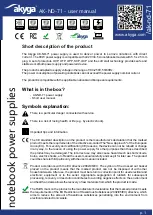
31
GB
Introduction / General safety advice for electrical power tools
vibration emission value specified can also serve as
a preliminary assessment of the exposure.
The vibration level will change according to the ap-
plication of the electrical tool an in some cases may
exceed the value specified in these instructions. Re-
gularly using the electric tool in such a way may
make it easy to underestimate the vibration.
note:
If you wish to make an accurate assessment
of the vibration loads experienced during a particular
period of working, you should also take into account
the intervening periods of time when the device is
switched off or is running but is not actually in use.
This can result in a much lower vibration load over
the whole of the period of working.
Q
General safety advice for
electrical power tools
read all the safety
advice and instructions!
Failure to
observe the safety advice and instructions
may result in electric shock, fire and / or serious injury.
Keep all the safety advice and instructions
in a safe place for future reference!
The term “electrical tool” used in the safety advice
refers to electrical tools powered by mains electric-
ity (by means of a mains lead) and electrical tools
powered by rechargeable batteries (without a
mains lead).
1.
Workplace safety
a)
Keep your working area clean and
well lit.
Untidy or poorly lit working areas
can lead to accidents.
b)
Do not work with the device in poten-
tially explosive environments in
which there are inflammable liquids,
gases or dusts.
Electrical power tools cre-
ate sparks, which can ignite dusts or fumes.
c)
Keep children and other people away
while you are operating the electrical
tool.
Distractions can cause you to lose con-
trol of the device.
2.
Electrical safety
a)
the mains plug on the power tool (or
on the power supply) must fit the mains
socket. never modify the plug in any
way. never use adapter plugs with
earthed power tools.
Unmodified plugs
and the correct sockets reduce the risk of elec-
tric shock.
b)
Avoid touching earthed surfaces such
as pipes, radiators, ovens and refrig-
erators with any part of your body.
There is an increased risk of electric shock if
your body is earthed.
c)
Keep the device away from rain or
moisture.
Water entering an electrical device
increases the risk of electric shock.
d)
Do not use the mains lead for any pur-
pose for which it was not intended,
e.g. to carry the device, to hang up the
device or to pull the mains plug out of
the mains socket. Keep the mains lead
away from heat, oil, sharp edges or
moving parts of the device.
Damaged
or tangled mains leads increase the risk of
electric shock.
e)
When working outdoors with an
electrical power tool always use ex-
tension cables that are also approved
for use outdoors.
The use of an extension
cable suitable for outdoor use reduces the risk
of electric shock.
f)
Use a residual current device (rCD)
for protection if operating the electri-
cal power tool in a moist environment
is unavoidable.
The use of an RCD reduces
the risk of electric shock.
3. Personal safety
a)
remain alert at all times, watch what
you are doing and always proceed
with caution. Do not use the device if
Introduction
Содержание PAS 3.6 B1
Страница 3: ...A B D C E 2 3 4 1 9 6 7 8 8 5 1 7...
Страница 4: ......







































